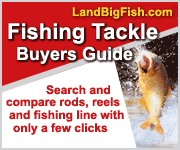It is a primal instinct carried over from man’s hunting and gathering days. These are the times of TV dinners and fast food meals, of canned and boxed and foiled and processed food. Yet we still get that compulsion now and then to go out there into the wild, wild world and catch our own food. Out there the fish are waiting. They are plentiful in our rivers, streams, ponds, lakes, beaches, seas, and oceans.
To catch a fish, one must have the right equipment. Hooks, lures and baits, rods and reels, lines, nets, and floats; in fisherman’s lingo all this gear is all called fishing tackle. Even the type of fishing outfit or clothing is included is commonly known as fishing tackle.

Before any fishing goes on and before tackle is procured, a savvy fisherman has to determine three things about what kind of fishing they will be doing. These 3 things are:
- Location – ocean, lake, river, or pier
- Species – freshwater or saltwater sport fish
- Size – most states regulate the size of each species that is legal to catch and keep
Decide on location, species and size and it becomes easy to choose the right fishing tackle to suit one’s need. Location basically means where one intends to go fishing. Size is simple enough and is closely related to species. What size and species of fish do you intend to catch?
There are a lot of different fishing gear on the market. Deciding on where you plan to fish and what you want to catch narrows your choices of gear. A word of advice for the new fisherman who wants to explore all possible ways of catching a fish – an all around all-purpose beginner’s kit would be best.
Photo credit: Wikipedia





